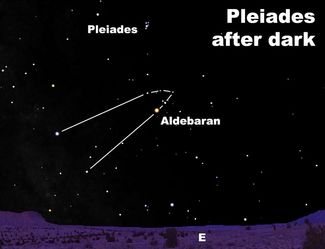Spotting the Seven Sisters
Last updated 12/1/2016 at 10:28pm
One of the wonderful features of the nighttime sky is its timelessness. Want to see the stars as viewed by sky watchers of old? Simply step outdoors and look up.
On December evenings, you can see a truly ancient constellation, Taurus, the bull, rising in the east after dark. Stargazers with a vivid imagination might be able to trace the stars of Taurus into the outline of a bull's head and long horns, with the bright star Aldebaran marking its fiery red eye. Aldebaran was one of the four Royal Stars of ancient Persia, along with the bright stars Antares, Regulus and Fomalhaut. Surrounding Aldebaran we can spot a V-shaped grouping of stars known to astronomers as the Hyades. In the lore of the ancients, from Greece all the way to China, the Hyades has been associated with wet and stormy weather; its name is said to come from an archaic Greek word meaning "to rain."
Only 150 light-years away, the Hyades forms the nearest open star cluster to Earth, and it may be only about 660 million years old. Though it seems that Aldebaran is part of this cluster, it actually lies less than half that distance away.
Riding on the back of Taurus appears a tiny grouping of stars often misidentified as the Little Dipper; it's really a cluster known as the Seven Sisters, so named because some stargazers can count seven stars within it with excellent vision under clear, dark skies. Astronomers know the cluster more properly as the Pleiades. The name is believed to derive from the Greek word meaning "to sail," because to ancient stargazers, the Pleiades rising just before the sun was a sign of the opening of the navigational season in the Mediterranean world.
In Greek mythology, these stars represented the half sisters of the Hyades who were saved from Orion's amorous pursuit by Zeus by transforming them into a group of celestial doves. It was in a 3rd century B.C. poem that Aratus gave us their individual names. It read:
"These the seven names they bear: Alcyone and Merope, Celaeno, Taygeta, and Sterope, Electra, and queenly Maia, small alike and faint. But by the will of Zeus illustrious all/ At morn and evening, since he makes them mark. Summer and winter, harvesting and seed-time."
The most famous reference to the Pleiades in English literature, however, occurs in the opening passages of Alfred Lord Tennyson's prophetic poem "Locksley Hall":
"Many a night I saw the Pleiads, rising thro' the mellow shade.
Glitter like a swarm of fireflies tangled in a silver braid."
If you've ever seen the Pleiades through a small telescope, you'd understand completely.
The Pleiades lie less than 400 light-years away and may only be between 50 and 100 million years old, making it a veritable cosmic youngster. You can almost always spot it, even under suburban light pollution, by casting your gaze slightly to the side of the cluster.
If you've never seen this magnificent star grouping shimmering in the east after dark, get out this week to do so. It is truly one of the most exquisite sights in all the heavens, and a harbinger of the upcoming winter season.




